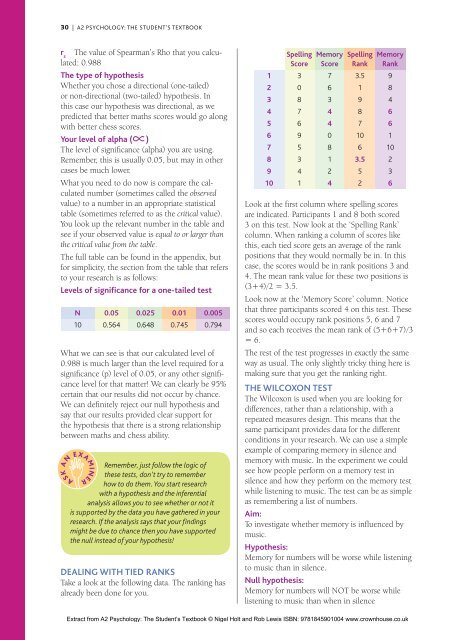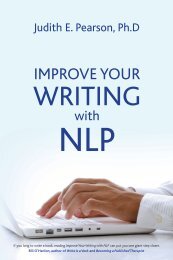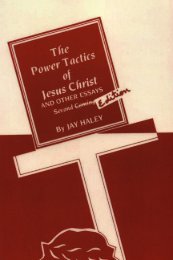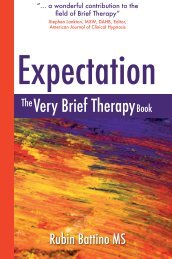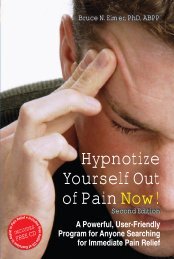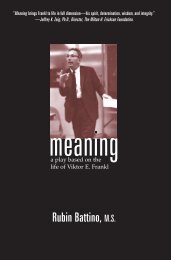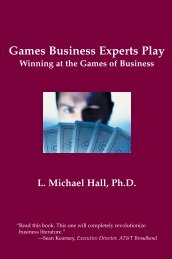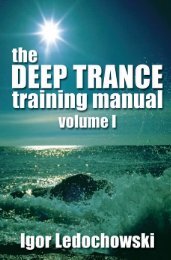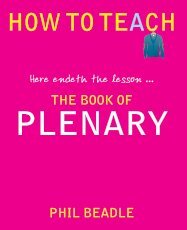Nigel Holt and Rob Lewis - Crown House Publishing.
Nigel Holt and Rob Lewis - Crown House Publishing.
Nigel Holt and Rob Lewis - Crown House Publishing.
Create successful ePaper yourself
Turn your PDF publications into a flip-book with our unique Google optimized e-Paper software.
30 | A2 PSYCHOLOGY: THE STUDENT’S TEXTBOOKr sThe value of Spearman’s Rho that you calculated:0.988The type of hypothesisWhether you chose a directional (one-tailed)or non-directional (two-tailed) hypothesis. Inthis case our hypothesis was directional, as wepredicted that better maths scores would go alongwith better chess scores.Your level of alpha (∝)The level of significance (alpha) you are using.Remember, this is usually 0.05, but may in othercases be much lower.What you need to do now is compare the calculatednumber (sometimes called the observedvalue) to a number in an appropriate statisticaltable (sometimes referred to as the critical value).You look up the relevant number in the table <strong>and</strong>see if your observed value is equal to or larger thanthe critical value from the table.The full table can be found in the appendix, butfor simplicity, the section from the table that refersto your research is as follows:Levels of significance for a one-tailed testN 0.05 0.025 0.01 0.00510 0.564 0.648 0.745 0.794What we can see is that our calculated level of0.988 is much larger than the level required for asignificance (p) level of 0.05, or any other significancelevel for that matter! We can clearly be 95%certain that our results did not occur by chance.We can definitely reject our null hypothesis <strong>and</strong>say that our results provided clear support forthe hypothesis that there is a strong relationshipbetween maths <strong>and</strong> chess ability.Remember, just follow the logic ofthese tests, don’t try to rememberhow to do them. You start researchwith a hypothesis <strong>and</strong> the inferentialanalysis allows you to see whether or not itis supported by the data you have gathered in yourresearch. If the analysis says that your findingsmight be due to chance then you have supportedthe null instead of your hypothesis!Dealing with tied ranksTake a look at the following data. The ranking hasalready been done for you.12345678910SpellingScore3087695341MemoryScore7634408124SpellingRank3.519871063.552MemoryRank98466110236Look at the first column where spelling scoresare indicated. Participants 1 <strong>and</strong> 8 both scored3 on this test. Now look at the ‘Spelling Rank’column. When ranking a column of scores likethis, each tied score gets an average of the rankpositions that they would normally be in. In thiscase, the scores would be in rank positions 3 <strong>and</strong>4. The mean rank value for these two positions is(3+4)/2 = 3.5.Look now at the ‘Memory Score’ column. Noticethat three participants scored 4 on this test. Thesescores would occupy rank positions 5, 6 <strong>and</strong> 7<strong>and</strong> so each receives the mean rank of (5+6+7)/3= 6.The rest of the test progresses in exactly the sameway as usual. The only slightly tricky thing here ismaking sure that you get the ranking right.The Wilcoxon TestThe Wilcoxon is used when you are looking fordifferences, rather than a relationship, with arepeated measures design. This means that thesame participant provides data for the differentconditions in your research. We can use a simpleexample of comparing memory in silence <strong>and</strong>memory with music. In the experiment we couldsee how people perform on a memory test insilence <strong>and</strong> how they perform on the memory testwhile listening to music. The test can be as simpleas remembering a list of numbers.Aim:To investigate whether memory is influenced bymusic.Hypothesis:Memory for numbers will be worse while listeningto music than in silence.Null hypothesis:Memory for numbers will NOT be worse whilelistening to music than when in silenceExtract from A2 Psychology: The Student’s Textbook © <strong>Nigel</strong> <strong>Holt</strong> <strong>and</strong> <strong>Rob</strong> <strong>Lewis</strong> ISBN: 9781845901004 www.crownhouse.co.uk


